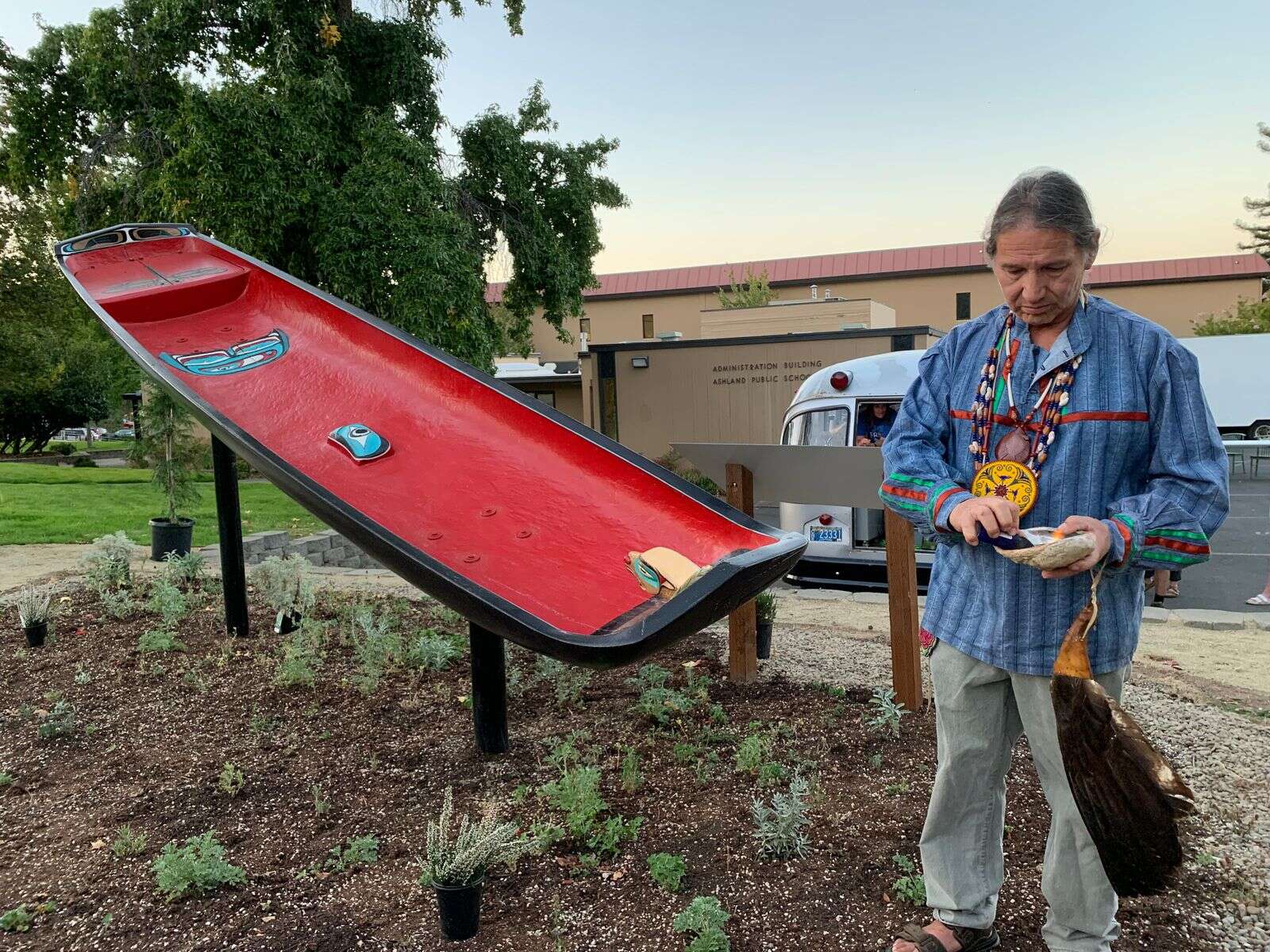Dan Wahpepah holds an eagle fan while burning tobacco leaves as part of a “blessing” ceremony Thursday to dedicate the new Otterlifter Canoe, a public art display outside Ashland High School. [Photo by Kevin Opsahl]
The Otterlifter Canoe near Ashland High School is hard to miss off Siskiyou Boulevard with its bright red paint displaying Native American artistry.
But anyone who steps near the canoe, donated from the Wahpepah family, and reads the large black-and-white panels to learn about the vessel will come to understand why it’s accepted that, over time, it will “gradually degrade” from exposure to the elements.
“Like all things, Otterlifter’s life is temporary,” one panel reads. “However, this installation is stewarded with compassion.”
That compassion came from groups like the high school’s Native American Student Union and Equity Committee, on hand Thursday to dedicate the canoe, which was installed over the summer.
“We understand that we’re in relation with all things — the plants, the river, the animals, the land,” Chantele Ritalos, a member of Siletz Tribe, said in remarks during a dedication ceremony in the high school commons. “The canoe, for our people, is no different. The canoe has a spirit.”
Twenty-two years ago, the vessel was carved from a 365-year-old sugar pine tree by two local men, George Fence, who was the chairman of the American Indian Cultural Center in Ashland before his passing, and Gray Eagle. Artist Ivan Otterlifter, for whom the canoe is named, oversaw the project until his death in 1999.
Decades later, Gray Eagle — who did not attend Thursday’s dedication — gave Dan Wahpepah the canoe because he was interested in making it an educational tool, owing to the fact his wife teaches at AHS. But, according to Wahpepah, the vessel sat in the high school library for a while, given COVID-19 restrictions for public gatherings, among other things.
Shane Abrams, an English and social studies teacher at Ashland High who advises the Truth to Power Club, acknowledged the hurdles in completing the project, which dates back to 2018. It was only this past school year that students became involved and started coming up with concept designs for the installation.
“(Thinking of how) to put it up safely and respectfully; in a way that was visible but not in danger,” Abrams said. “Dan mentioned it’s a living being, so we don’t want it to get hurt in any way.”
Abrams characterized Thursday’s dedication as a “big night” but emphasized he is not the one who should get credit for the project.
“As a team — a collection of stakeholders of different ages and responsibilities — the work we’ve done is something we’re really proud of,” Abrams said.
Ken Engelund, a member of Ashland Public Arts Commission, understands what the Otterlifter Canoe conveys. He learned about the vessel when Ashland High students made a presentation to the commission earlier this year; the commission approved it and recommended it be seconded by Ashland City Council — which it did.
“We were very impressed,” Engelund said, referring to the Public Arts Commission’s reaction to the students’ presentation. “It was just really inspiring to see the leadership of young people.”
Engelund saw the canoe inside district property before it was installed outside. Now, he believes the vessel is all the more striking as it sits just off Siskiyou Boulevard.
“I think it’s a really wonderful, meaningful piece of public art,” Engelund said. “It will provide students educational opportunity, understanding and, hopefully, attitudes about inclusion and appreciation for the district. It certainly does that for me.”
Though the canoe is new to its current location, this type of vessel dates far back in the history of local Native American people and is especially significant to them.
“(The canoe) represented trade-gathering, hunting and all the things that fed the family,” Wahpepah said.
In fact, the canoe itself is a family member, he added.
“The canoe is fed, as well; the canoe is put to sleep in the fall and then woken up in the spring,” Wahpepah said.
He pointed to a bump on the bottom of the vessel that represents its “heart.”
“If it doesn’t have that heart, it’s not a canoe because the canoe is a family member,” Wahpepah said.
He knows one thing the vessel does not represent — war.
“This canoe is about regenerative lifestyle,” Wahpepah said. “It represents a … reminder that there were people here that lived regeneratively for thousands of generations and who contributed to the land. (The canoe) is a reminder of a return to the good life.”
In remarks at Thursday’s dedication ceremony, Wahpepah railed against a lifestyle of “colonization” and asked the community to think about choices that are destroying Earth, such as burning fossil fuels.
“We’re living in a topsy-turvy world,” Wahpepah said. “We want to find our way back to a regenerative lifestyle.”
Lupe Sims, a Native American who graduated in 1992 from Ashland High, noted the difficulties of being only one of five people of color in her graduating class, having no teachers who looked like her.
“There is (much) work that has happened and much work that needs to be done,” Sims said at the dedication. “Especially within the education system, where all of our kids are learning colonization. There needs to be truth-telling; that has not happened.”
Thirty years since graduating, Sims said she is glad an educational tool like the Otterlifter Canoe is on the AHS campus to stay.
“I think the canoe is amazing; it is a statement of cultural sovereignty,” Sims said. “We have to fight for every single day, as people of color, as Indigenous people. We have to make statements, and they have to be loud statements because if we don’t, then we’re not recognized.”
Reach reporter Kevin Opsahl at 541-776-4476 or kopsahl@rosebudmedia.com. Follow him on Twitter @KevJourno.
